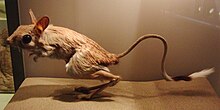| Dipodoidea Temporal range:
| |
|---|---|

| |
| Jaculus orientalis | |
| Scientific classification | |
| Domain: | Eukaryota |
| Kingdom: | Animalia |
| Phylum: | Chordata |
| Class: | Mammalia |
| Order: | Rodentia |
| Suborder: | Myomorpha |
| Superfamily: | Dipodoidea Fischer de Waldheim, 1817 |
| Families | |
Dipodoidea is a superfamily of rodents, also known as dipodoids, found across the Northern Hemisphere. This superfamily includes over 50 species among the 16 genera in 3 families.[2][3] They include the jerboas (family Dipodidae), jumping mice (family Zapodidae), and birch mice (family Sminthidae).[3] Different species are found in grassland, deserts, and forests. They are all capable of saltation (jumping while in a bipedal stance), a feature that is most highly evolved in the desert-dwelling jerboas.
- ^ Qian Li; Yan-Xin Gong; Yuan-Qing Wang (2017). "New dipodid rodents from the Late Eocene of Erden Obo (Nei Mongol, China)". Historical Biology: An International Journal of Paleobiology. 29 (5): 692–703. Bibcode:2017HBio...29..692L. doi:10.1080/08912963.2016.1232406. S2CID 132602246.
- ^ Holden, M.E.; Musser, G.G. (2005). "Family Dipodidae". In Wilson, D.E.; Reeder, D.M. (eds.). Mammal Species of the World: A Taxonomic and Geographic Reference (3rd ed.). Johns Hopkins University Press. pp. 871–893. ISBN 978-0-8018-8221-0. OCLC 62265494.
- ^ a b Lebedev, Vladimir S.; Bannikova, Anna A.; Pagès, Marie; Pisano, Julie; Michaux, Johan R.; Shenbrot, Georgy I. (2013). "Molecular phylogeny and systematics of Dipodoidea: a test of morphology-based hypotheses". Zoologica Scripta. 42 (3): 231–249. doi:10.1111/zsc.12002. ISSN 1463-6409. S2CID 86686066.